We did not choose this house for its gardening possibilities. We are not that crazy, despite what our children say. We chose it, I suspect, because it was built of logs and surrounded by trees and made us feel as though we really were living in Montana.
Of course, as you scan the photo below you’re probably thinking, "What house?" Which is precisely the point. Long-time residents of Bozeman have had to be talked in to our front steps via cell-phone, because they couldn’t see the house for the trees. (That white clapboard in the lower left? That’s the neighbor’s house.)
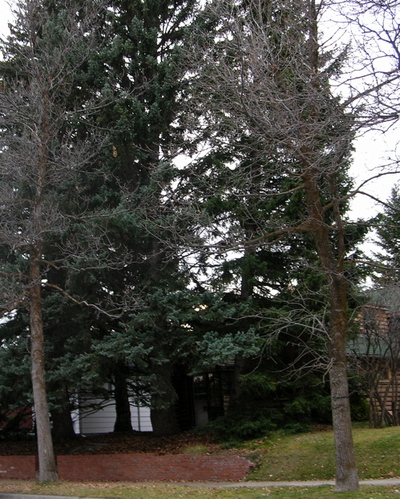 The West’s contribution to my "garden" is two clumps of conifers, one fore and one aft, which do wonders for ambiance but nothing for the vegetables. Don’t get me wrong — they’re great trees and I love them: love the smell, and the sound, and the sense of forest they bring to our home — but they’re hell on gardening.
The West’s contribution to my "garden" is two clumps of conifers, one fore and one aft, which do wonders for ambiance but nothing for the vegetables. Don’t get me wrong — they’re great trees and I love them: love the smell, and the sound, and the sense of forest they bring to our home — but they’re hell on gardening.
So much so that I’ve variously begged and bullied until my husband has agreed to take down several of the smaller ones: a sickly cedar and two young but bushy items whose identity remains unknown, though ash is on the suspect list. The rest of the family (the afore-mentioned husband and our two sons) look on such cullings with grave disapproval, and I am persona non gratis after each tree-attack. (Arthritis keeps me out of the direct tree-cutting business, to their relief no doubt, and restricts my role to nagging, to their regret.) After one particularly active tree-cutting season, my older son, seeing me get ready to go outside, would ask acerbically, "Going to cut down a tree?"
Given my ostracization, it was a relief that the telephone company took out one of the trees. For that one at least, I bear no responsibility.
Even after all this pruning, there is literally no place on our lot that gets full sun. It’s not a big lot to begin with. The front "yard", on the east side of the house, is a non-starter, being occupied by four sixty-foot tall spruce trees, and therefore by nothing else save a lot of pine needles.
The north is a narrow strip of grass, neither big nor sunny enough to do much. Let’s not go there.
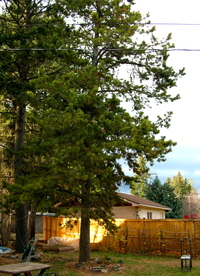 The west side of the house actually has a few square feet of ill-tended scrappy lawn, (with a pine in the middle, naturally) a gradually disintegrating log garage (with another large pine by it), and more trees, all conifers now that I’ve had my way with the other ash, save for a non-bearing choke cherry. (Too much shade, perhaps?).
The west side of the house actually has a few square feet of ill-tended scrappy lawn, (with a pine in the middle, naturally) a gradually disintegrating log garage (with another large pine by it), and more trees, all conifers now that I’ve had my way with the other ash, save for a non-bearing choke cherry. (Too much shade, perhaps?).
To the south, the front-yard spruce grove continues its hegemony, adding another great tree to its number. (As a result, the house stays marvelously cool in summer, and remarkably cold in winter.) Then there’s the cement patio, where I grow tomatoes in a row of barrels up against the house. Of course, they’re shaded by a tree (deciduous for once) that grows just over the fence by the neighbor’s house.
The projecting roof of that house actually shoves the tree towards us, creating an exemplary illustration of the silver-lining theory (every silver lining requires a cloud), for it (the tree, not the theory) provides welcome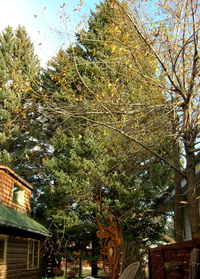 patio shade in summer but equally unwelcome shade for my container plants in summer and fall. Round October it (the tree) seems to be deciduous only in theory (a different theory), or at least dedicated to the proposition that all trees, not just Russian olives, should hang onto their leaves all year, for fall is what they don’t and don’t and don’t, though as you can see in the photo to the right taken on November 11th, they finally do. All along the south fence our neighbor’s yard offers a steady supply of shade for our lawn and for my peas and lettuce: a chokecherry that does bear entwined in something big and dead, a miniature plum, a crab apple, another ash, and then their share of conifers.
patio shade in summer but equally unwelcome shade for my container plants in summer and fall. Round October it (the tree) seems to be deciduous only in theory (a different theory), or at least dedicated to the proposition that all trees, not just Russian olives, should hang onto their leaves all year, for fall is what they don’t and don’t and don’t, though as you can see in the photo to the right taken on November 11th, they finally do. All along the south fence our neighbor’s yard offers a steady supply of shade for our lawn and for my peas and lettuce: a chokecherry that does bear entwined in something big and dead, a miniature plum, a crab apple, another ash, and then their share of conifers.
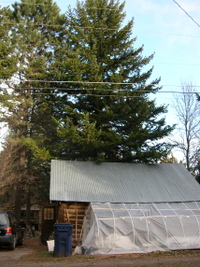 This leaves the strip along the alley, beyond the garage. Of course, because of the garage, the tree over it, the trees in our neighbor’s yard, and the pines in ours, that strip gets no sun until between twelve and two, depending on the season, and thanks to the tall lilac hedge across the alley (not to mention the two-storey garage) the sun lasts until between five and six. My alley plots therefore get between three and six hours of full sun — not what’s generally recommended for squash or eggplant.
This leaves the strip along the alley, beyond the garage. Of course, because of the garage, the tree over it, the trees in our neighbor’s yard, and the pines in ours, that strip gets no sun until between twelve and two, depending on the season, and thanks to the tall lilac hedge across the alley (not to mention the two-storey garage) the sun lasts until between five and six. My alley plots therefore get between three and six hours of full sun — not what’s generally recommended for squash or eggplant.
That’s the situation: a small, urban lot (in Montana!) with eight major conifers on it, a bunch of other trees on and around, and a die-hard glutton-for-punishment ex-New Yorker trying to raise a few organic vegetables on what’s left.
So if this post seems to be increasingly hung-over, or over-hung, by large, looming trees; if the text seems in danger of disappearing into a forest of photographs, well, all I can say is, Yup.
From our yard, it’s not such a big sky at all.
–Kate Gardner

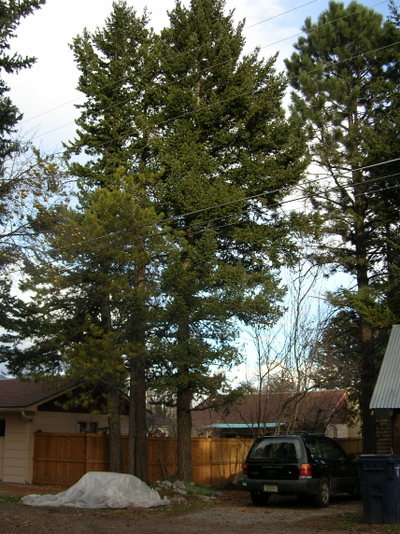
 Subscribe to RSS feed
Subscribe to RSS feed


